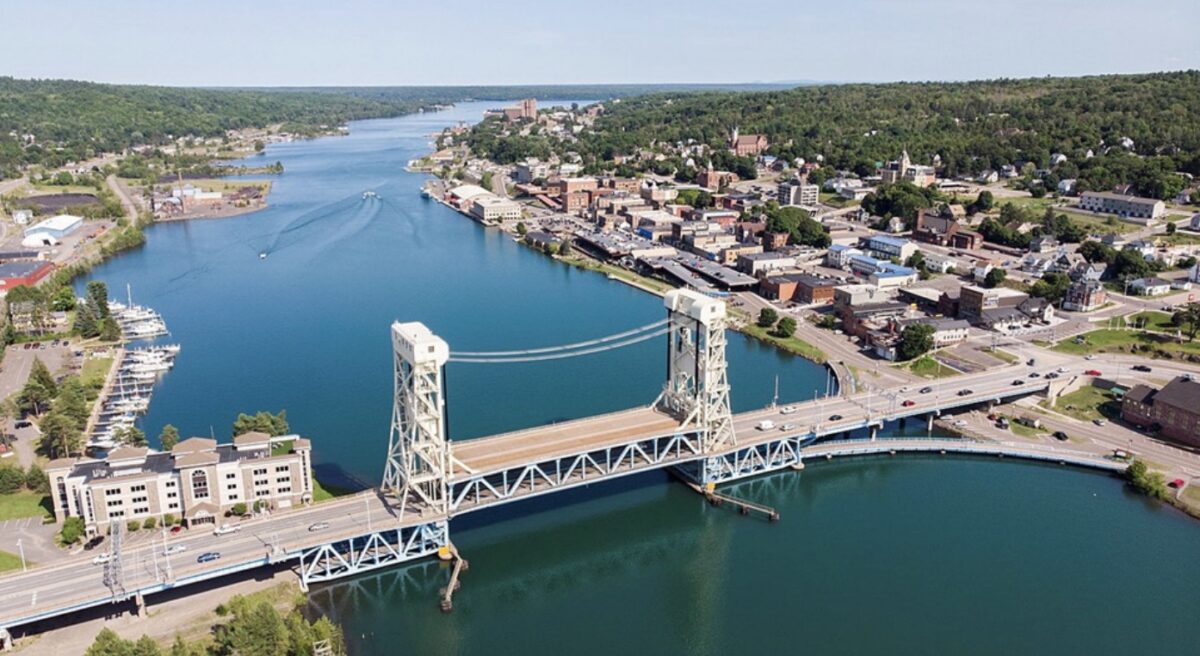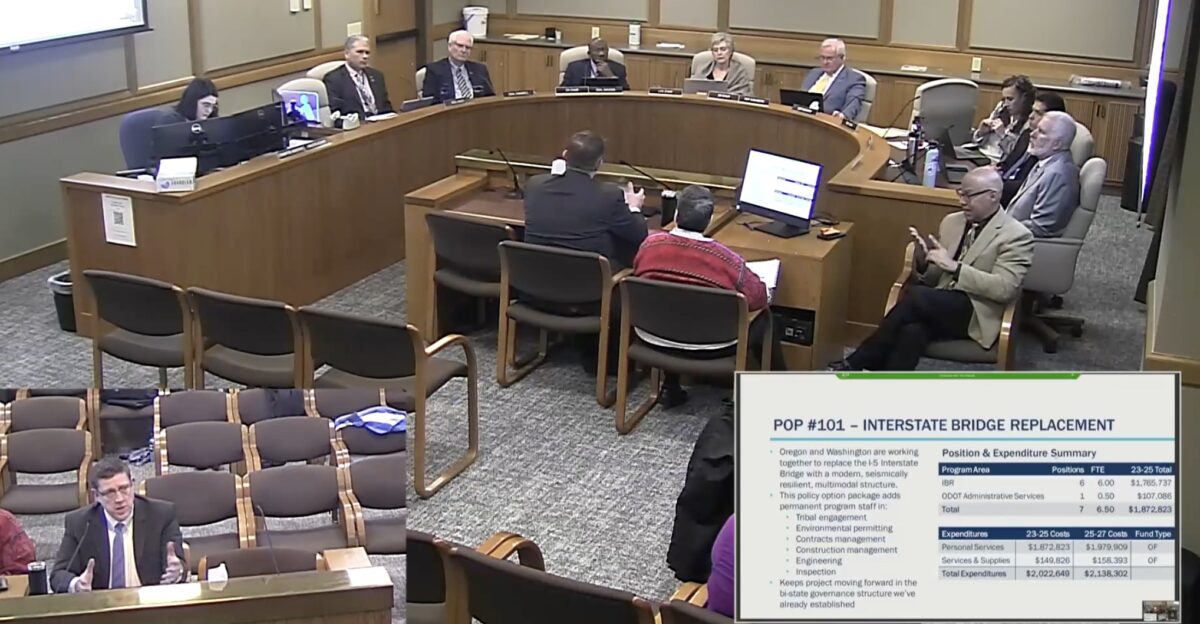 A bridge in Michigan shared as one example of a lift span by the Interstate Bridge Replacement Program.
A bridge in Michigan shared as one example of a lift span by the Interstate Bridge Replacement Program.
— By Taylor Griggs and Jonathan Maus
The plan to expand the I-5 freeway between Portland and Vancouver, known as the Interstate Bridge Replacement Program (IBRP), has had some success over the last year or so. It has broad local political support and even got name-dropped by President Joe Biden. But that doesn’t mean it’s been all smooth sailing.
Speaking of boats…
Whether or not they can fit under the currently proposed design has suddenly become a much bigger deal. As reported by The Oregonian Tuesday, the U.S. Coast Guard is putting their foot down when it comes to their demands that the project do a more thorough review of a movable lift-span (drawbridge) option.
IBRP Administrator Greg Johnson told BikePortland via email this morning that the Coast Guard delivered a letter to the Federal Highway Administration and the Federal Transit Administration in February requesting a study of a design option that provides 178 feet of river clearance. “To do this, the program is moving forward with studying a movable span as part of the National Environmental Protection Act (NEPA) review process,” Johnson shared. He says doing the study now is a “risk mitigation strategy” because it can be folded into the existing review process and could prevent more significant delays later in the process.
In his comments to BikePortland, Johnson was very careful to show unwavering support for the existing fixed-span design:
“The program understands that external stakeholders want to move forward with a fixed span. We appreciate the responsibilities that the Coast Guard oversees and acknowledge the need to better understand the full range of benefits and impacts associated with a replacement bridge across the Columbia River. Additionally, the program will continue conversations with potentially impacted fabricators and businesses, who have expressed support for the replacement of the bridge and interest in mitigation agreement discussions necessary for a fixed span.”
This all started in June of last year, when the Coast Guard informed the IBRP team that their plan for a 116-foot tall bridge across the Columbia River wasn’t going to fly. The Coast Guard wanted at least 178 feet of vertical space for ships to pass underneath. But the IBRP team was insistent that a lower bridge would work. They said a lift-span would be too expensive and complex and that it would be much cheaper and easier to simply work with a handful of individual ship operators to mitigate passage concerns. All the while, ODOT and WashDOT seemed to brush off the Coast Guard’s threats, even though the maritime agency made it clear they wouldn’t budge and some insiders rang alarm bells.
For now it looks like the Coast Guard has won this high stakes game of chicken. ODOT and WashDOT must now include a formal review of a movable span design in the federal environment review process. And keep in mind: delays are deadly for megaprojects, especially one that already died once and comes with a pricetag that could reach $7.5 billion.
Lawmakers are watching
“Does the Coast Guard have veto power?”
 ODOT Director Kris Strickler faced questions about the bridge height at a March 13th legislative committee meeting.
ODOT Director Kris Strickler faced questions about the bridge height at a March 13th legislative committee meeting.
“Yes… my hope is that it never constitutes a veto authority, though.”
The former IBRP (the Columbia River Crossing) died because politicians backed away from it. Now, headlines about this latest design snafu have made their way to lawmakers in Salem.
At a meeting of the Joint Committee On Ways and Means Subcommittee On Transportation and Economic Development Monday, Oregon Department of Transportation Director Kris Strickler was asked about the bridge height issue by Senator Bill Hansell (R-29).
“I just heard today… that the federal government had some issue with our design… care to comment on that?” Sen. Hansell asked.
“At the macro scale, the design is pretty well-formed,” Strickler replied. “But when you look at the details of the bridge itself, we are still looking at the movable span portion.” Then, without being asked about the cost, he added, “Would it cost more? Absolutely. I can tell you unequivocally that the cost of a moveable span is more than the cost of a fixed span. We don’t know how much more yet, but it could be upwards of $500 million, just for the bridge portion alone.” (Strickler also took the opportunity to remind lawmakers that a drawbridge that would be raised about 400 times per year would have a negative impact on light rail headways.)
In his comments Wednesday, Strickler tried to keep things lighthearted. “The Coast Guard is one of the federal cooperating agencies that partners with FTA and FHWA through this process,” he said at one point. “So it’s not like we’re in a position where we can tell them, ‘We’re just not going to evaluate your concept’.”
Then Sen. Hansell got right to the point on everyone’s mind: “Does the Coast Guard have veto power?”
And Strickler, always careful with his comments, replied. “I’ll define that by saying yes, because they have a bridge permit that we have to get in order for us to enter into construction. So my hope is that it never constitutes a veto authority, though.”
Tunnel vision
As we’ve covered in the past, Vancouver-based engineer Bob Ortblad has been ardently advocating for the IBRP to consider an immersed tube tunnel connection between Vancouver and Portland for a long time, saying it would be safer and more visually pleasing to the city skylines than a steep, hulking bridge. This idea has received little in the way of institutional support, but last week one person of note joined the tunnel team: Vancouver Mayor Pro Tem Ty Stober.
In a March 10th Facebook post, Stober expressed his disappointment with the IBR program hurdles, saying “the economy of Southwest Washington needs an updated crossing as soon as possible” and urging them to look for alternatives.
“It would be a tragedy to replace one draw bridge on Interstate 5 with another one,” Stober wrote. “I am calling on the IBR team to do a fresh, complete study of a tunnel. The benefit would be to reconnect downtown Vancouver to Fort Vancouver and open the skyline.”
On the Oregon side, House Rep. Mark Gamba brought up the tunnel at Wednesday’s legislative meeting. He asked Strickler why it hadn’t been given more consideration.
After saying one reason they don’t like the tunnel idea is because it would requiring “a significant amount of material waste… we’re talking millions of cubic yards,” Strickler said he doesn’t think a tunnel would provide adequate access to freeway interchanges used by the ports of Oregon and Washington. “… The tunnel idea provides complications in providing access to each of those [interchanges] in a way that makes it something that is technically, relatively infeasible,” he said.
What’s next?
 (Photo: Jonathan Maus/BikePortland)
(Photo: Jonathan Maus/BikePortland)
The IBR planners don’t want a moveable span bridge, and they really don’t want a tunnel. But they’re not going to get the federal support they need for the project if they don’t play ball with the Coast Guard. Now they have to hope the additional review goes quickly and comes out in a way that proves a lift-span isn’t a good option.
“I feel pretty confident that we’ll get a fair evaluation and we’ll come up with what’s right for the community,” Strickler said.
IBRP Administrator says now that a movable span is officially in the NEPA review process, the public will get a chance to provide public input once the EIS comes out later this year.
On the advocacy side, in a press release from Just Crossing Alliance (JCA), a coalition of organizations who want a “right sized” project, member Brett Morgan with 1000 Friends of Oregon indicated this is a moment for the IBRP to make things right:
“One ‘alternative’ is not really a choice,” Morgan wrote in a statement. “And isn’t responsive to partners. The JCA has been saying since the early days of the project reboot that we need to bring along multiple alternatives.”

Taylor has been BikePortland’s staff writer since November 2021. She has also written for Street Roots and Eugene Weekly. Contact her at This email address is being protected from spambots. You need JavaScript enabled to view it.

